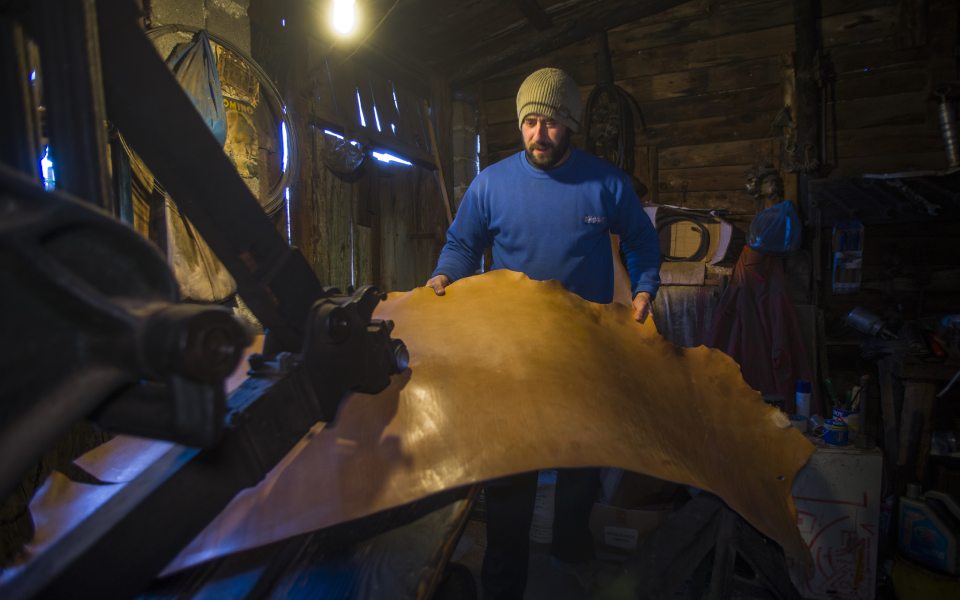
Tanner
As I headed to Amfissa in Central Greece, I knew that I had to visit the Charmaina neighborhood, one of the must-sees in the area. It was built on a hill over the city and is characterized by narrow streets, stone houses – most of them in ruins – and breathtaking views. The city's leather tanneries once operated in this neighborhood. As I walked around, I came across the workshop of local tanner Spyros Merinopoulos. Standing under a canopy of leather hides hanging from the ceiling, he recounted the history of the area. He told me about his grandfather and his father’s time, when the neighborhood was bustling with life and orders were flowing in from all around Europe, including the Vatican. He also explained that the leather that was processed in the most natural way possible was the type that was best for bookbinding and gold printing. Today, his tannery is the only one operating in the neighborhood.
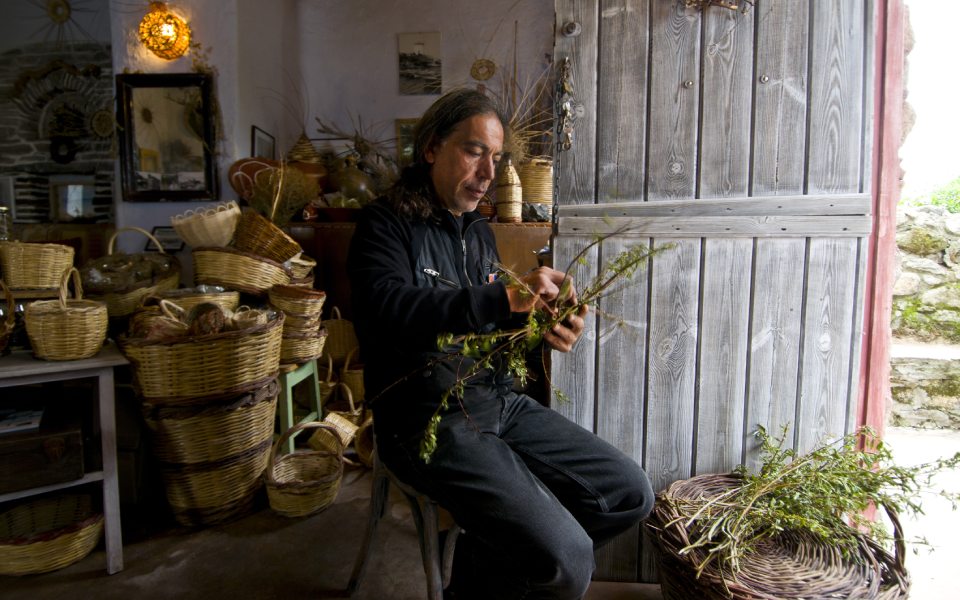
Basketmaker
The first thing that caught my eye as I approached Volax on the island of Tinos were the legendary boulders that surround the village and seem to have come from another world. As I began walking through the village’s small streets. I couldn't put my camera down. I was snapping away non-stop when I found myself in front of a basket weaver's workshop. Iosif Vidos was sitting outside, quietly weaving a basket. I envied him for being able to work in such a relaxed way. He welcomed me with a coffee and showed me how he begins to make a basket, which thin branches he uses and how freshly cut they should be. As I watched him work, I thought about how vital baskets were for people in the time before electricity, cars, or televisions, when paper or plastic bags did not exist. Watching his easy hand movements and his relaxed demeanor, I also reflected on how contagious his calm attitude towards life could be. After all, there's something that's soothing about weaving a basket, whether you're making it for practical or, as is more likely these days, for decorative purposes.
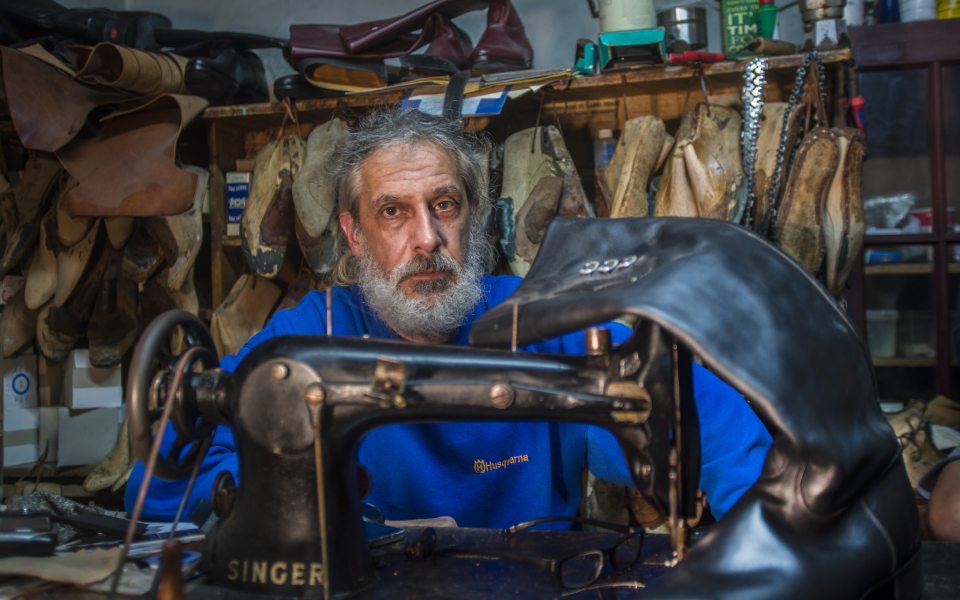
Bootmaker
I once traveled with some colleagues through the Hania region of Crete, traversing the whole area, end to end, for days. At one point, we crossed the Askyfou Plateau in search of the village of Ammoudari and Ieronimos Gialedakis, one of the last bootmakers who specialize in "stivania" – traditional Cretan leather boots. It wasn't until nightfall that we finally found ourselves at his workshop. “Bring glasses and chairs for the girls,” Gialedakis told his friends who were gathered, drinking “tsikoudia,” a Cretan variety of pomace brandy. After we raised our glasses in a happy toast, he began telling us why the boots he made were so special, how they're usually black but can occasionally be white, and how they're always only made to order, tailored to each foot. He asked me to remove my shoes so he could show me how to take proper foot measurements. Once he'd done this, I seized on the opportunity; I ordered a pair of my own. It had been a long time since I'd felt such joy: in a few short days, I would have stivania of my own, boots that would fit my feet, and my feet only!
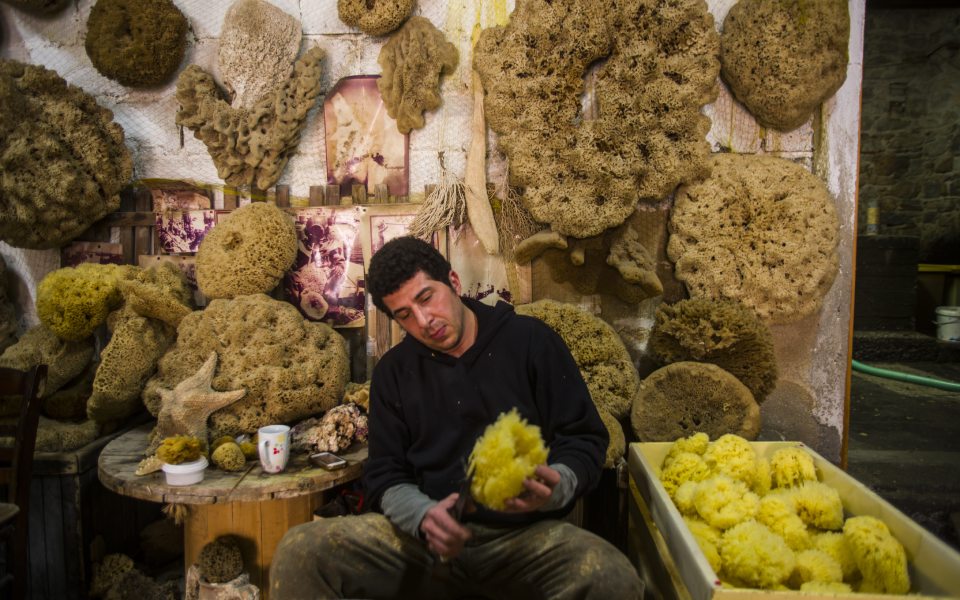
Sponge diver
If you walk around the village of Pothia on the island of Kalymnos, you'll see sponges lying on the sidewalks and in the squares, drying under the sun. Today, there are only about ten sponge-fishing vessels left in the area and yet there are still sponges everywhere. It's hard to imagine what it must have looked like when there was still a fleet of at least 100 vessels! These boats carried the fearless sponge divers who, for generations, harvested them from the sea floor. At first, they relied on only the most primitive methods, but over time, equipment and techniques changed. Nonetheless, diving for sponges still requires tremendous courage: the danger of expiring at the bottom of the sea or of coming back to the surface half-paralyzed by the bends always remains. With these thoughts in mind and filled with admiration and awe for the divers, I made a stop at the Charami workshop. Here I learned that after the harvesting comes the processing. Inside the building, there were thousands of sponges. Most were stowed in crates but the more unusual or beautiful ones were hung on the walls for decoration. One of the workshop employees, a polite if somewhat shy man, explained to me more about sponge diving and how the sponges were cleaned and clipped to end up on the market and in our bathrooms. From that moment on, I knew that I'd never look at a sponge the same way again: it wouldn't be just an object anymore, but rather something to be respected for the history of its industry.
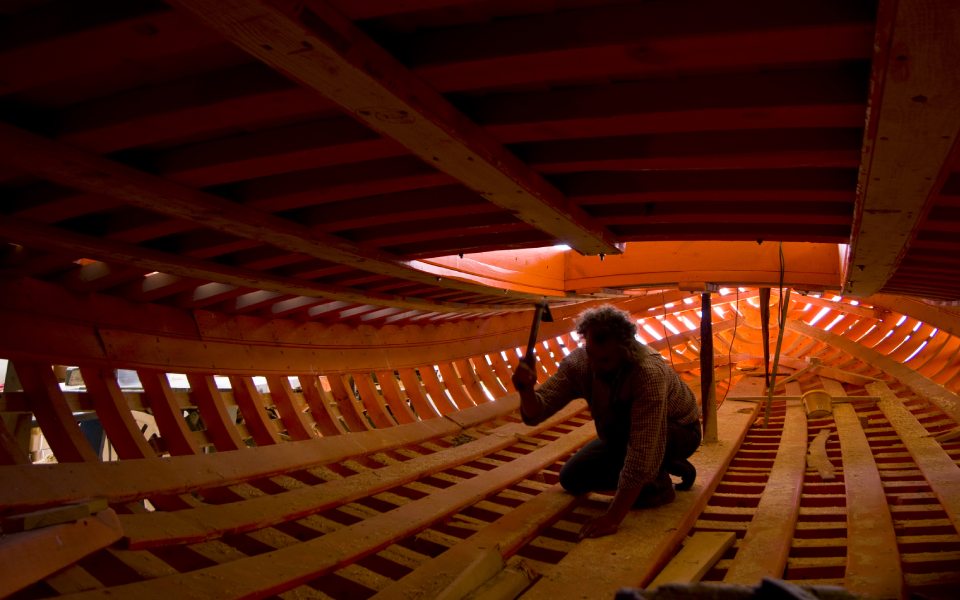
Shipwright
I have always been fascinated by “kaïkia,” the traditional small wooden boats that ply the Ionian and Aegean seas. I enjoy traveling on them, photographing them or simply watching them navigate the waters, leaving behind a delicate white wake. When I met with shipwright Doukas Yamoyiannis at his shipyard located in Plomari, on the island of Lesvos, I was even more fascinated by what I learned. He spoke with passion about the choice of tree for boat lumber, and about where and when it should be cut in order to extract the best parts for the keel. “It’s the keel of the boat that will withstand the storm’s turbulence,” he told me, his eyes twinkling and his hands stroking the wooden prow of a kaïki under construction. “Each piece of wood gets cut for a purpose and in a specific way, depending on the part of the boat it will be used for.”
Yamoyiannis was taught his craft by his father and his grandfather. The family company has been building kaïkia since 1888; before that, his predecessors made only sailboats. Today, Yamoyiannis builds speed boats or any other craft for which he receives orders, always with the same passion and devotion. Unfortunately, these elements aren’t always appreciated nowadays; the charm of careful craftsmanship has been replaced with plastic and low-cost labor.
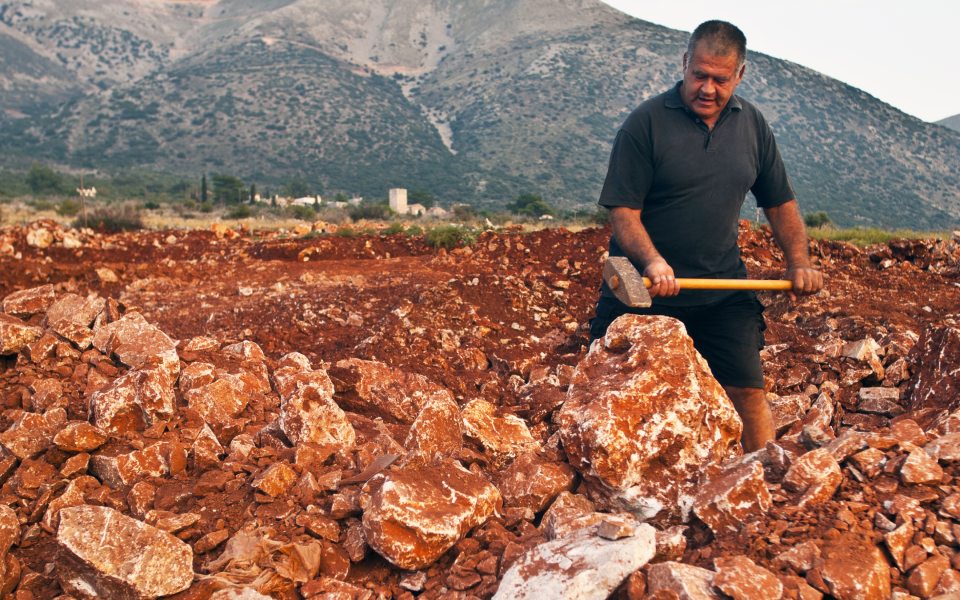
Stonemason
In Greece, there is stone everywhere you look. Stone is the oldest construction material; it is a symbol of resistance and hardiness. Yet in the hands of some people it becomes precious, and even seems malleable. In the village of Tsopakas in the Mani region of the Peloponnese, I met Pierros Mavroeidongonas, a stonemason who operates by the rules of Maniot architecture. He told me about his work and his life: “You start by establishing how you will break the stone, how you will sculpt it. You should know where you will use it, depending on its shape, color and hardness.” After a few hits on a rock with a sledgehammer, he continued: “Everything we build is stable and can last forever. If it’s a house, it has the best natural insulation. It’s also beautiful, because it’s made from a local material that blends harmoniously into the natural landscape…” He spoke for a long time, praising the stone. “I used to say that Maniots are as hard as stone, and I said it like it was a bad thing; I understand now that things can’t be bad, if you treat them with the respect they deserve. And if you do, you may find an ally and a protector in a stone, as well as in a person.”










